Quick Start Guide: Decel Mode - Performance Box Touch V2
- Last updated
- Save as PDF
|
The Performance Box Touch provides you with a wealth of information combined with easy installation and use. Performance Box Touch V2 contains an integrated high-performance, 25 Hz GNSS engine and antenna, as well as a port for an external antenna. Performance Box Touch has 4 modes available; Accel, Decel, Lap Timing and Speed. They allow you to conduct a range of performance tests and functions and can be changed by pressing the Mode button at the bottom of the screen. When you use Performance Box Touch in Decel Mode, you get:
|
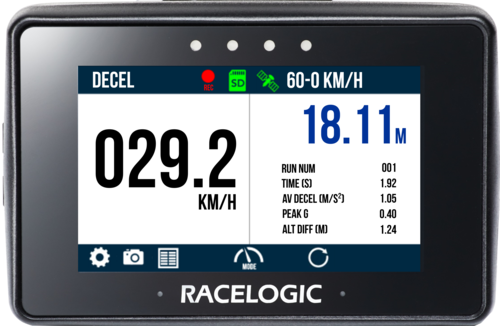 |
Registration
Please register your Performance Box Touch so that Racelogic can continue to inform you about the latest software releases and firmware upgrades and offer technical support.
Register your unit here.
What is in the box?
Performance Box Touch V2 (RLPBT-V2)
| Product Code | Quantity | Description |
|---|---|---|
| PBT-V2 | 1 | Performance Box Touch Unit |
| RLACS184 | 1 | Cigar Plug USB Adapter |
| USB2-007241 | 1 | USB 2.0 A to Right Angle Micro B data and Charging Cable, 1.5 m |
| RLACS313 | 1 | 8 GB SD Ultima Pro UHS-1 Memory Card |
| RLACS331 | 1 | Suction Cup Windscreen Mount |
Performance Box Touch V2 Bundle (RLPBT/B)
| Product Code | Quantity | Description |
|---|---|---|
| RLPBT-V2 | 1 | Performance Box Touch Kit (see content table above) |
| RLACS290 | 1 | Performance Box Touch Battery and Cable |
| RLACS284 | 1 | GPS/GLONASS Low Profile Antenna, 2 m |
| RLACS281 | 1 | Plastic Carry Case |
Power
The supplied USB cable (USB2-007241) plugs into the Power socket on the right-hand side of the unit. Use the supplied Cigar Plug USB Adapter (RLACS184) and the vehicle's 12 V cigar power socket to power the Performance Box Touch.
You can also power the Performance Box Touch with the optional battery (RLACS290 – available from Racelogic). You can find more information on the battery below.
When booting up, the Performance Box Touch will display a splash screen and automatically look for satellites and media.

The first time the unit is booted up, it will present the Display Mode screen. Every time after this, it will present the previously used display mode.
Battery
|
To give you the opportunity to use the unit without connecting it to a power source, we have an optional battery (RLACS290) available for the Performance Box Touch. When the battery is installed, you can press and hold the Power button on the battery for a few seconds to turn the unit on or off. If you plug the power cable into the unit when the battery is already attached to the unit, the unit will turn on automatically. The battery will provide at least 6 hours of battery life. However, you can increase the battery life to a maximum of 9 hours by using the minimum brightness settings. |
 |
| When Performance Box Touch is on, and the battery is installed, you will see a Battery Status Indicator displayed in the top right corner of the screen. This will provide you with a visual representation of the remaining battery charge. The indicator is split into 10 bars, each representing a 10% charge. When the battery is charging, you will see a charging symbol appear over the battery symbol. | |
| If the battery has less than a 10% charge left, you will see a warning screen appear on the display, which will be displayed for 10 seconds. To cancel the warning, press anywhere on the screen. |
You can find the full battery specifications here.
Charging
When the battery is installed in the Performance Box Touch, it will charge while the unit is being powered via a power source. You can also charge it while it is removed from the unit by using the supplied USB cable (USB2-007241). Note that the USB port on the battery is located above the Power button.
The battery needs approximately 3.5 hours to charge. To shorten the charging time, we recommended that you charge the battery from a mains power source while it is disconnected from the Performance Box Touch.
If you are experiencing issues when charging the battery, take a look at our troubleshooting page.
Auto Power-Off
When Performance Box Touch is 'idle' (tracking zero satellites, not logging and has no screen interactions for 5 consecutive minutes), it will power off to preserve the battery.
Before it powers off, it will display a warning screen. If you do not want it to power off, you can cancel the process by pressing anywhere on the screen within the 10 second time limit.
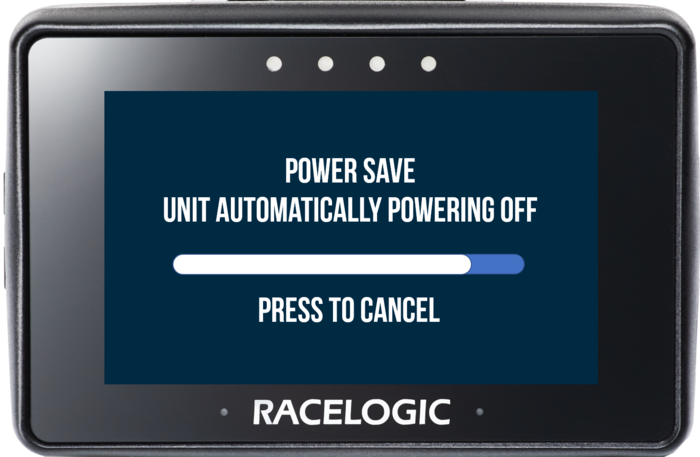
Auto Power-off Warning Screen
Using Gloves with Performance Box Touch
Just like modern mobile phones and tablets, Performance Box Touch is operated using a capacitive touch screen display. However, this does mean that if you are wearing gloves, they will need to be capacitive touch compatible to allow for interaction with the touch screen.
There are many types of capacitive touch compatible gloves available for purchase. If you are unsure which gloves you need, please do not hesitate to contact Racelogic.
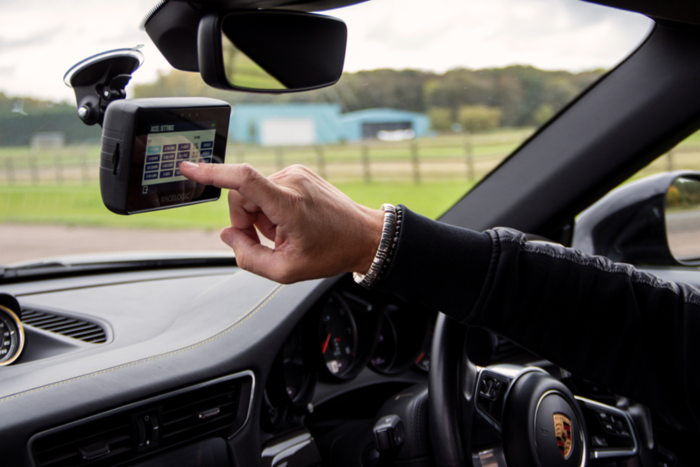 |
 |
Installation
| The battery is connected to Performance Box Touch with a Richter mounting system on the rear of the unit. Insert the prongs from the back of the battery into the rear of the Performance Box Touch unit and push upwards to secure. |
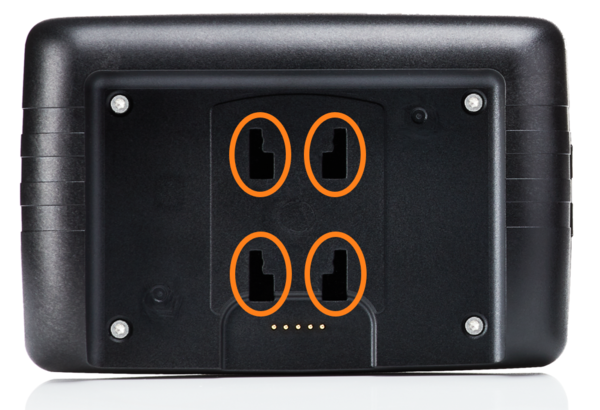 Richter mounting system on the back of Performance Box Touch |
|
| Performance Box Touch comes supplied with a Suction Cup Windscreen Mount (ACS318MOUNT) so you can mount it on the vehicle's windscreen. It attaches to the Richter mounting system on the back of the unit, or at the back of the Battery if this is connected to the unit. |
|
|
Richter Mounting system on Suction Cup Windscreen Mount (RLACS331) |
| Insert the prongs from the mount into the back of the unit or the battery and push upwards to secure. Attach the suction cup to a suitable location on your windscreen and adjust as necessary. | |
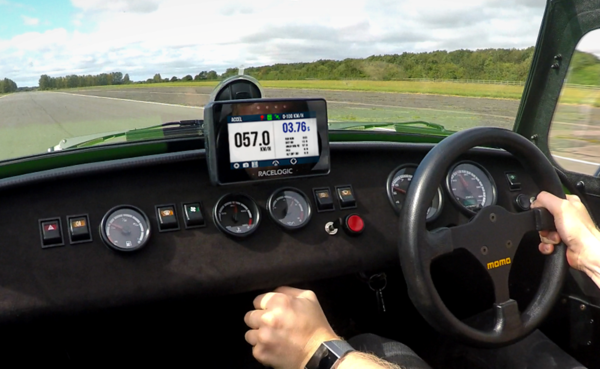
Satellite Reception
| Performance Box Touch has an internal patch antenna. This means that, in many circumstances, the unit does not require an external antenna if it has a clear view of the sky without any interference (e.g. roof bars, athermic windscreen, windscreen wipers). However, if you are struggling to maintain a stable satellite lock (indicated by a flashing red satellite icon), you can use an external antenna (RLACS284). |  |
| IMPORTANT The first time you use the unit, it may take 10 to 15 minutes to acquire satellites fully. After this, it will usually only take 1 to 2 minutes to acquire satellites. |
|
External Antenna (If Required)
|
The placement of the GNSS antenna is crucial to the quality of the data recorded by Performance Box Touch. Any metal close to a GNSS antenna can unpredictably disturb the signal due to interference from reflections of weak GNSS signals. For best results, use the antenna in the centre of a metal roof at least 5 cm away from any roof bars or radio antennas. Do not mount the antenna close to the edge of the roof as reflections from the ground may interfere with the signals. Avoid the edges as reflections from the A-pillars will cause problems. Mount the antenna as high up as possible and keep it above any roll bars. Pieces of metal close to and above an antenna will badly disrupt the GNSS signal. |
| If the vehicle you are using does not have a metal roof, you need to place the GNSS antenna on a flat piece of metal at least 10 cm in diameter. If this is not possible, you can use copper or aluminium foil to create a shaped ground plane underneath the antenna. For example, on a fibreglass roof, mount the antenna on top of the roof, and place some adhesive-backed metal foil underneath, on the inside of the roof. |
|
|
Acquiring Satellite Lock
| Tall buildings or trees can block GNSS signals, causing a reduction in the number and quality of satellites being tracked. The reduced number of satellites can lead to inaccurate position measurements and a noisy velocity signal. |
| GNSS works best in open areas. Avoid tree-lined roads. |
GPS Coldstart
|
If Performance Box Touch is struggling to acquire a satellite lock, you may need to perform a GPS coldstart. This may be necessary when the unit hasn’t been used for several days or has moved location significantly since it was last used. To perform a coldstart, press the COLDSTART button in the Diagnostics Settings menu. |
.png?revision=1) |
| When you press the button, the unit will make an audible sound and you will see a ‘PLEASE WAIT’ message counting down from 3. Until the satellite lock has been acquired, the number of satellites will be displayed as '00' and the GPS status will show ‘SEARCHING FOR SATELLITES’. It will take approximately 25 to 30 seconds for the unit to reacquire the satellite lock. |
|
You can access the Settings menu on Performance Box Touch by selecting the Settings button on the bottom left of the screen when in a mode. You will see a Select Settings Screen with 4 Settings options: Mode settings, General Settings, Time settings and Diagnostic settings. |
 |
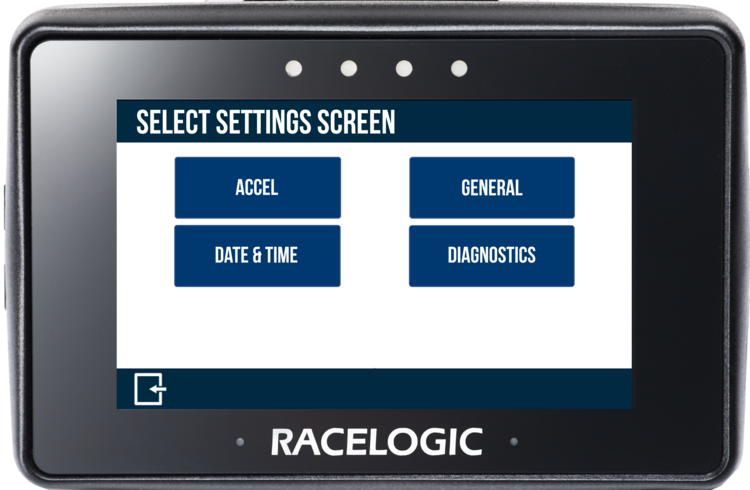 |
|
| You can change the settings by pressing the corresponding button next to an option. | |
| To return to the Select Settings Screen, press the Exit button at the bottom left. Pressing it again in the Select Settings Screen will return you to the main screen. |  |
In these settings menus, you will be able to configure your Performance Box Touch to suit your purpose. The settings included are:
Decel Settings
General Settings
| This menu has settings for units, logging mode, format for saving and the screen and LED brightness. |
Time Settings
| This menu contains date and time settings. |
Diagnostics
| The Diagnostics menu displays basic information about the GNSS receiver and the VBOX unit and its battery. |
Performance Box Touch V2 – Decel Mode
| Deceleration Mode is where you can perform deceleration tests using either pre-defined configurations or your own specified values. You can access it by pressing the Mode button at the bottom of the screen and selecting Decel. |
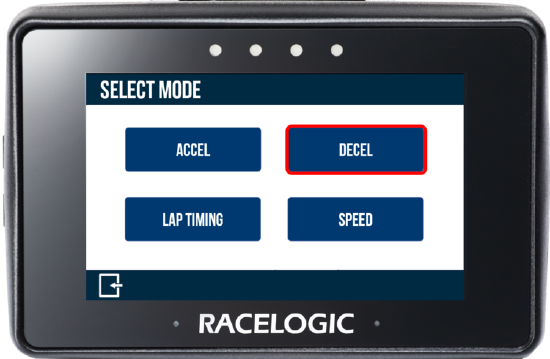 |
|
The previously selected Deceleration test will be displayed after each power cycle. You use speed parameters to start and end the test. The test results displayed on the screen will remain on-screen at the end of the test until the next start condition is met. The speed units used in the test results depend on what you have selected in the General Settings area. |
Decel Mode Overview
| The Deceleration screen displays current and completed test information. |
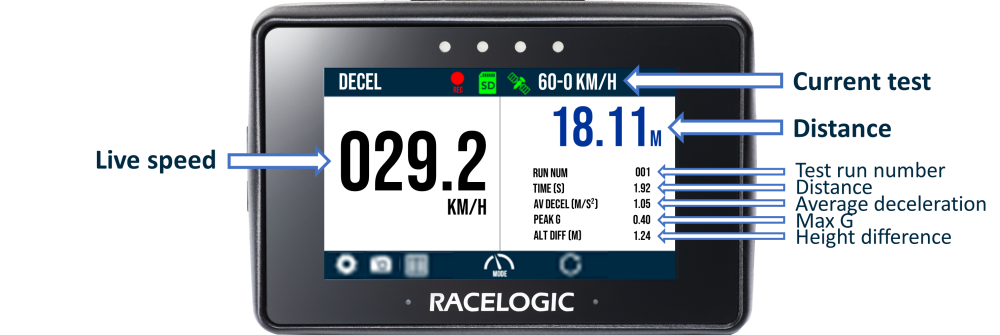 |
|
The screen is split into 2 halves:
Note: If you are using the battery, the Current Test header will not include units to make space for the battery status indicator. |
Selecting a Test
| You can choose a Decel Test by pressing the Settings button on the bottom left of the screen. Preset and custom test options are then available on the right-hand side of the displayed screen. |
_v2.png?revision=1) |
| The test that is currently selected will be highlighted and will be remembered for future use, even if you choose another mode. |
Preset Tests
|
The Performance Box Touch has preset 5-speed Decel tests. Press a test to select it. The '60 – 0' test is selected by default.
When you select a test, the name of the test will be displayed at the top right corner of the Decel Mode screen. |
Custom Test
| You can choose your own start and end conditions by pressing the Custom Test button at the bottom right of the test area. |
 |
| You can then define the start and end speed conditions by pressing the corresponding blue value buttons. |
_-_No_Frame-v2.png?revision=1&size=bestfit&height=340) |
| Keypad Example Start Speed |
|
Use the presented keypad to select a value and press the Confirm button at the bottom right of the screen to save it. Press the Cancel Button at the bottom left of the screen to return to the Settings screen without saving. Note: The maximum input value for speed is 999.9 and you can entered up to 1 decimal place. |
 |
 |
|
To save the Custom Test you have set, press the Confirm button at the bottom right of the screen. Press the Cancel button at the bottom left of the screen to go back to the Decel Mode screen without saving.
|
Decel Settings
| You can access the Decel Mode settings screen by selecting the Settings button at the bottom left of the screen. This is where you can set the test parameters and select other test options. |
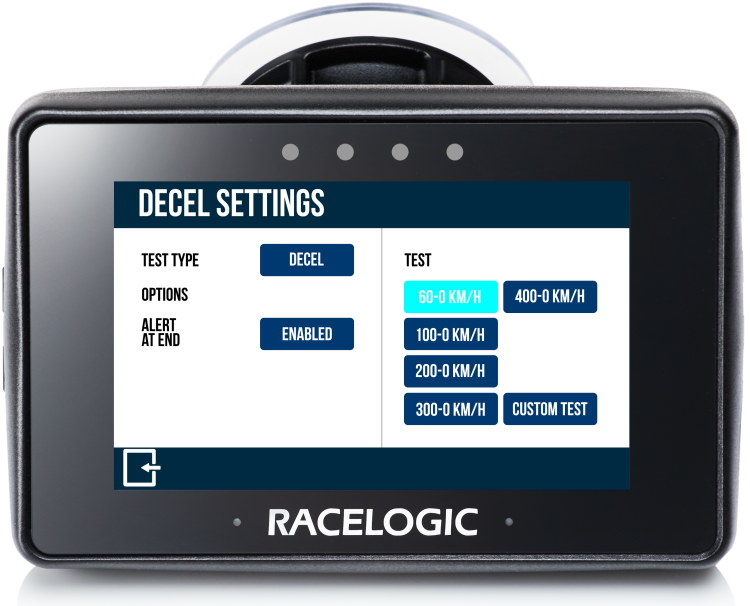 |
| To return to the main screen, select the Exit button at the bottom left of the screen. |  |
Alert at End
 |
| By default, the Performance Box Touch has audible and visual alert signals for when the test end criteria are met. It will beep and the 4 LEDs across the top of the device will flash green for 0.5 s. Tap the corresponding blue button to toggle between Disabled and Enabled. |
Test History
|
You can view a history of the test results by selecting the Results button at the bottom of the screen. The test results will display until you choose a new test type or you press the Reset button. |
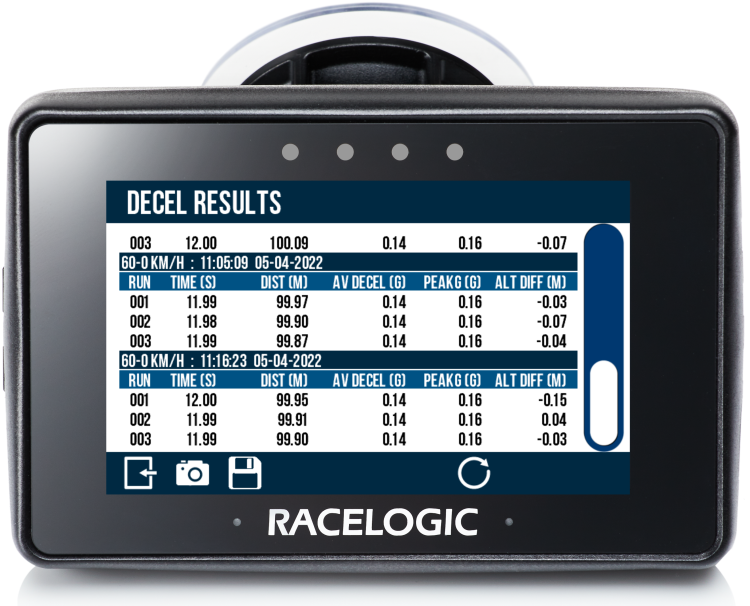 |
| Results screen sample |
|
The tests will be displayed in chronological order and the fastest will be highlighted. You can scroll through the results by using the scroll bar on the right-hand side of the screen. Each new session will have a separate header, displaying the time and date for the first completed test in that session. Information includes:
You can take a screenshot of the test history by pressing the Screenshot button.
|
| To return to the main screen, press the Exit button at the bottom left of the screen. |  |
Save Results
|
You can also save the results as a .txt or .csv file (depending on the option selected) to the SD card by selecting the Save button at the bottom of the screen. When you press this button, the unit will emit an audible confirmation notification. If the results have been saved unsuccessfully, for example, if no SD card is inserted or the card is full, the button will flash 3 times and Performance Box Touch will emit an audible error notification. If saved successfully, the file name will include the test type, the date and also the time, taken from the first completed run in that session. Along with the test history information described above, the results file also includes average acceleration information, as well as the latitude and longitude position (in degrees and decimal degrees format) added to the session header. |
 |
Reset
| Pressing the Reset button at the bottom right of the screen will reset all test results shown on the current screen. When you press it, the LEDs will briefly flash green twice and the unit will emit an audible confirmation notification. |
Logging
| Performance Box Touch logs data via an SD card inserted into the SD Card Slot on the left-hand side of the unit. Depending on the Logging Strategy you have selected in the General Settings, the unit will either log continuously or only when it detects movement. |
| You can manually override the configured logging strategy by tapping on the SD Card Icon when it is green to start or stop the logging. |  |
|
The Record Icon will show when the unit is logging data to the SD card. If you have come to a stop, but the Record Icon is still on, you must press the SD Card Icon to stop the logging before you remove the SD card.
Note: If the SD card is removed while the box is still recording, you may need to repair it on a PC before you can use it again. |
 |
SD Card Format
|
Performance Box Touch V2 is supplied with an 8 GB SDHC card in a FAT32 file format, which is the only file format it supports. If you are looking to purchase a new SD card, we recommend that any card you use has a write speed of above 7 MB/s (4 MB/s is the absolute minimum) and a speed class of 10 (4 is the absolute minimum). We recommend that you use SD cards from quality brands such as Transcend, SanDisk, Kingston or Lexar to ensure the best results. IMPORTANT |
SDHC cards (2 GB to 32 GB)
| Supplied or purchased SDHC cards are formatted in the FAT32 file format. This format is supported by Performance Box Touch V2. |
SDXC cards (64 GB and above)
| Purchased SDXC cards will be formatted in exFAT or NTFS file formats; these formats are not supported by Performance Box Touch V2. Please reformat as per the instructions below. |
SD Card Reformatting
|
SD Card Format
|
Performance Box Touch V2 is supplied with an 8 GB SDHC card in a FAT32 file format, which is the only file format it supports. If you are looking to purchase a new SD card, we recommend that any card you use has a write speed of above 7 MB/s (4 MB/s is the absolute minimum) and a speed class of 10 (4 is the absolute minimum). We recommend that you use SD cards from quality brands such as Transcend, SanDisk, Kingston or Lexar to ensure the best results. IMPORTANT |
SDHC cards (2 GB to 32 GB)
| Supplied or purchased SDHC cards are formatted in the FAT32 file format. This format is supported by Performance Box Touch V2. |
SDXC cards (64 GB and above)
| Purchased SDXC cards will be formatted in exFAT or NTFS file formats; these formats are not supported by Performance Box Touch V2. Please reformat as per the instructions below. |
You can read more about the different types of SD Cards and how you can make them work with your Performance Box Touch here.
Logged Channels
|
Performance Box Touch logs channels to a .vbo file on an inserted SD card. The channel information is as follows:
|
LED Behaviour
General
The 4 LEDs at the top of the unit provide visual feedback dependent on what process is being performed:
- Decel Mode: If Alert at End is enabled, the LEDs will flash green for 0.5 s once the test end criteria are met.
- Screenshot: If a screenshot has been saved successfully, the LEDs will illuminate yellow in sequence from left to right to display the progress of writing to the SD card.
- Reset: The LEDs will briefly flash green twice when a screen has been reset.
- Battery (if installed): If the battery has run out of charge, the LEDs will flash red five times before the unit turns off.
Battery
The separate battery has its own LED next to the Power button. This will provide constant battery status information.
| LED | Description |
|---|---|
| Green (flashing when charging, unless charge ≥90%) | >20% charge |
| Orange (flashing when charging) | 10–20% charged |
| Red (flashing when charging) | 0–10% charge |
| 5 red flashes before turning off | 0% charge |


.png?revision=1)